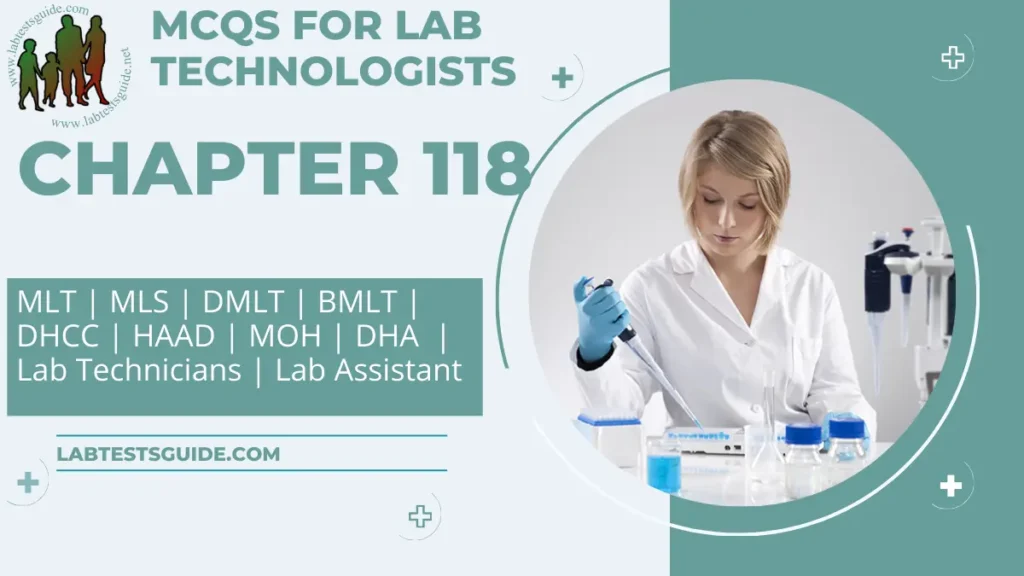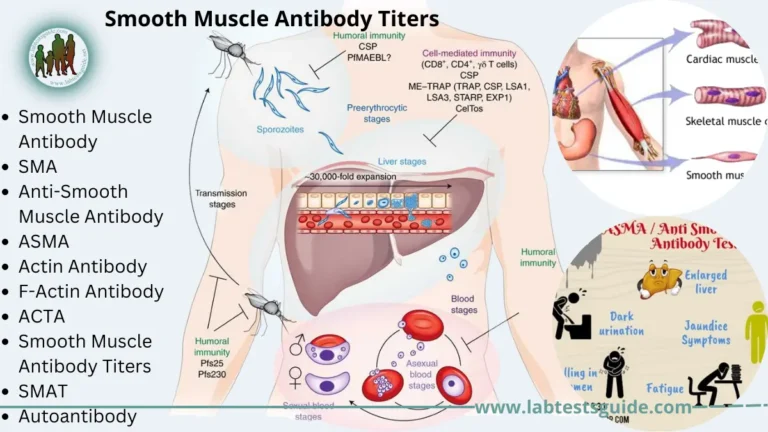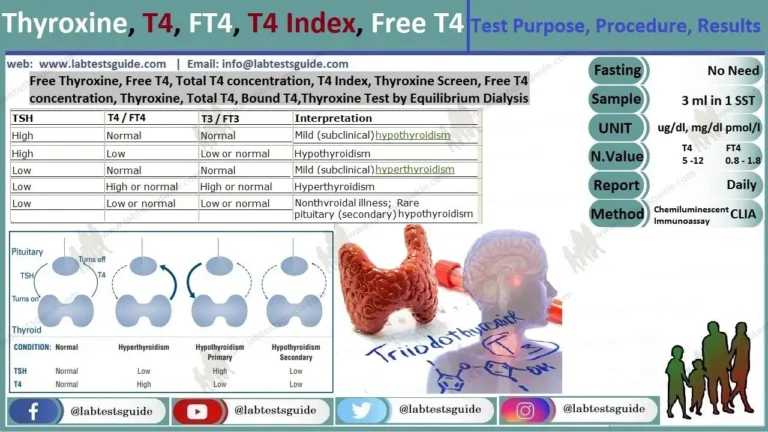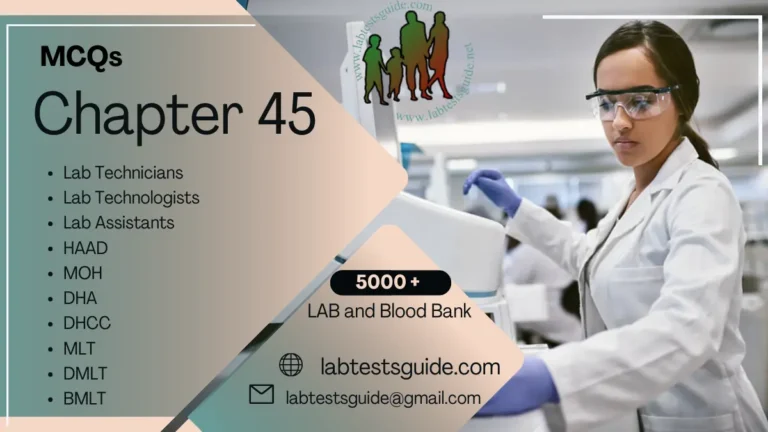5851 to 5900 MCQs for Lab Technician and Technologist Exam Preparation
5000 Plus MCQs for Lab Technician and Technologists are designed to test the knowledge and proficiency of laboratory professionals who work in the field of clinical laboratory science. These questions cover a wide range of topics related to laboratory science, including anatomy, physiology, microbiology, chemistry, and hematology.

If You like then share this to your friends and other social media.
If You have any question and suggestions then please Contact us Here
Questions 5851 to 5900
- NADPH required for fatty acid synthesis can come from
- Hexose monophosphate shunt
- Oxidative decarboxylation of malate
- Extramitochondrial oxidation of isocitrate
- All of these ✔
- Fatty liver may be prevented by all of the following except
- Choline
- Betaine
- Methionine
- Ethionine✔
- Human desaturase enzyme system cannot introduce a double bond in a fatty acid beyond
- Carbon 9 ✔
- Carbon 6
- Carbon 5
- Carbon 3
- Which of the following lipid is absorbed actively from intestines?
- Glycerol
- Cholesterol
- Monoacylglycerol
- None of these✔
- C22 and C24, fatty acids required for the synthesis of sphingolipids in brain are formed by
- De novo synthesis
- Microsomal chain elongation ✔
- Mitochondrial chain elongation
- All of these
- Sphingomyelins:
- Phospholipids ✔
- Nitrolipids
- Alcohols
- None of these
- All of the following statements about hypoglycin are true except
- It is a plant toxin
- It causes hypoglycaemia
- It inhibits oxidation of short chain fatty acids ✔
- It inhibits oxidation of long chain fatty acids
- Synthesis of prostaglandins is inhibited by
- Glucocorticoids
- Aspirin
- Indomethacin
- All of these ✔
- Lipo-oxygenase is required for the synthesis of
- Prostaglandins
- Leukotrienes ✔
- Thromboxanes
- All of these
- All of the following statements about multiple sclerosis are true except
- There is loss of phospholipids from white matter
- There is loss of sphingolipids from white matter
- There is loss of esterified cholesterol from white matter ✔
- White matter resembles gray matter in composition
- Release of free fatty acids from adipose tissue is increased by all of the following except
- Glucagon
- Epinephrine
- Growth hormone
- Insulin ✔
- All the following statements about brown adipose tissue are true except
- It is rich in cytochromes
- It oxidizes glucose and fatty acids
- Oxidation and phosphorylation are tightly coupled in it ✔
- Dinitrophenol has no effect on it
- Lovastatin and mevastatin lower
- Serum triglycerides
- Serum cholesterol ✔
- Serum phospholipids
- All of these
- Lovastatin is a
- Competitive inhibitor of acetyl CoA carboxylase
- Competitive inhibitor of HMG CoA synthetase
- Non-competitive inhibitor of HMG CoA reductase
- Competitive inhibitor of HMG CoA reductase✔
- Abetalipoproteinaemia occurs due to a block in the synthesis of
- Apoprotein A
- Apoprotein B ✔
- Apoprotein C
- Cholesterol
- All of the following statements about Tangier disease are true except
- It is a disorder of HDL metabolism
- Its inheritance is autosomal recessive
- Apoproteins A-I and A-II are not synthesised
- Plasma HDL is increased ✔
- Genetic deficiency of lipoprotein lipase causes hyperlipoproteinaemia of following type:
- Type I ✔
- Type IIa
- Type IIb
- Type V
- Chylomicrons are present in fasting blood samples in hyperlipoproteinaemia of following types:
- Types I and IIa
- Types IIa and IIb
- Types I and V ✔
- Types IV and V
- Glutathione is a constituent of
- Leukotriene A4
- Thromboxane A1
- Leukotriene C4 ✔
- None of these
- Prostaglandins are inactivated by
- 15-Hydroxyprostaglandin dehydrogenase ✔
- Cyclo-oxygenase
- Lipo-oxygenase
- None of these
- Phenylbutazone and indomethacin inhibit
- Phospholipase A1
- Phospholipase A2
- Cyclo-oxygenase ✔
- Lipo-oxygenase
- For extramitochondrial fatty acid synthesis, acetyl CoA may be obtained from
- Citrate ✔
- Isocitrate
- Oxaloacetate
- Succinate
- Fluidity of membranes is increased by the following constituent except
- Polyunsaturated fatty acids
- Saturated fatty acids ✔
- Integral proteins
- Cholesterol
- Transition temperature of membranes may be affected by the following constituent of membranes:
- Peripheral proteins
- Integral proteins
- Cholesterol ✔
- Oligosachharides
- Acetyl CoA formed from pyruvate can be used for the synthesis of all the following except
- Glucose ✔
- Fatty acids
- Cholesterol
- Steroid hormones
- Which of the following can be used as a source of energy in extrahepatic tissues?
- Acetoacetate ✔
- Acetone
- Both (Acetoacetate) and (Acetone)
- None of these
- Anti-inflammatory corticosteroids inhibit
- Phospholipase A1
- Phospholipase A2 ✔
- Cyclo-oxygenase
- Lipo-oxygenase
- Cyclo-oxygenase is involved in the synthesis of
- Prostaglandins
- Thromboxanes
- Both (Prostaglandins ) and (Thromboxanes) ✔
- None of these
- Leukotrienes cause
- Increase in capillary permeability✔
- Aggregation of platelets
- Bronchodilatation
- None of these
- Prostaglandins decrease all of the following except
- Gastric acid secretion
- Blood pressure
- Uterine contraction ✔
- Platelet aggregation
- Hypocholesterolaemia can occur in
- Hyperthyroidism ✔
- Nephrotic syndrome
- Obstructive jaundice
- Diabetes mellitus
- De novo synthesis and oxidation of fatty acids differ in the following respect:
- Synthesis occurs in cytosol and oxidation in mitochondria ✔
- Synthesis is decreased and oxidation increased by insulin
- NADH is required in synthesis and FAD in oxidation
- Malonyl CoA is formed during oxidation but not during synthesis
- Free fatty acids released from adipose tissue are transported in blood by
- Albumin ✔
- VLDL
- LDL
- HDL
- The enzyme deficient in metachromatic leukodystrophy is
- Arylsulphatase A✔
- Hexosaminidase A
- Ceramidase
- Sphingomyelinase
- All of the following statements about generalized gangliosidosis are true except
- It results from deficiency of GM1-βGangliosidase
- Breakdown of GM1 ganglioside is impaired
- GM2 ganglioside accumulates in liver and elsewhere ✔
- It leads to mental retardation
- Hexosaminidase A is deficient in
- Tay-Sachs disease ✔
- Gaucher’s disease
- Niemann-Pick disease
- Fabry’s disease
- Mental retardation occurs in
- Tay-Sachs disease
- Gaucher’s disease
- Niemann-Pick disease
- All of these ✔
- The enzyme deficient in Fabry’s disease is
- α-Galactosidase ✔
- β-Galactosidase
- α-Glucosidase
- β-Glucosidase
- Highest protein content amongst the following is present in
- Wheat
- Rice
- Pulses
- Soyabean ✔
- Daily protein requirement of an adult man is
- 0.5 gm/kg of body weight
- 0.8 gm/kg of body weight ✔
- 1.0 gm/kg of body weight
- 1.5 gm/kg of body weight
- Daily protein requirement of an adult woman is
- 0.5 gm/kg of body weight
- 0.8 gm/kg of body weight✔
- 1.0 gm/kg of body weight
- 1.5 gm/kg of body weight
- Cysteine can partially meet the requirement of
- Phenylalanine
- Threonine
- Methionine ✔
- None of these
- Invisible fat is present in
- Milk ✔
- Coconut oil
- Groundnut oil
- Hydrogenated oils
- Visible fat is present in
- Milk
- Pulses
- Coconut oil ✔
- Egg yolk
- Fat content of eggs is about
- 7%
- 10%
- 13% ✔
- 16%
- Fat content of pulses is about
- 5% ✔
- 10%
- 15%
- 20%
- Predominant fatty acids in meat are
- Saturated ✔
- Monounsaturated
- Polyunsaturated
- Mono and poly-unsaturated
- Oils having more than 50 % polyunsaturated fatty acids include all of the following except
- Groundnut oil ✔
- Soyabean oil
- Sunflower oil
- Safflower oil
- Cholesterol is present in all of the following except
- Egg
- Fish
- Milk
- Pulses ✔
- Which of the following has the highest cholesterol content?
- Meat
- Fish
- Butter ✔
- Milk
The questions are typically designed to assess the technical skills and knowledge required for the laboratory profession, including the ability to analyze laboratory test results, perform laboratory procedures, and maintain laboratory equipment.
To prepare for these MCQs, candidates should have a thorough understanding of the key concepts and principles of laboratory science. They should also be familiar with common laboratory equipment and procedures, as well as laboratory safety protocols.
Candidates may also benefit from studying specific laboratory science textbooks or taking online courses that cover the material tested in the MCQs. Additionally, practicing sample MCQs and reviewing the answers can help candidates identify areas where they may need to improve their knowledge or skills.
Overall, the MCQs for lab technologists are designed to be challenging and comprehensive, requiring candidates to demonstrate a high level of proficiency in the field of laboratory science.
Possible References Used





